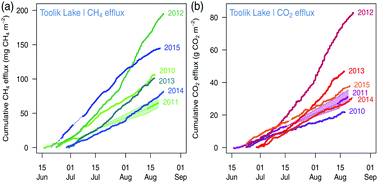Interannual, summer, and diel variability of CH4 and CO2 effluxes from Toolik Lake, Alaska, during the ice-free periods 2010–2015†
Abstract
Accelerated warming in the Arctic has led to concern regarding the amount of carbon emission potential from Arctic water bodies. Yet, aquatic carbon dioxide (CO2) and methane (CH4) flux measurements remain scarce, particularly at high resolution and over long periods of time. Effluxes of methane (CH4) and carbon dioxide (CO2) from Toolik Lake, a deep glacial lake in northern Alaska, were measured for the first time with the direct eddy covariance (EC) flux technique during six ice-free lake periods (2010–2015). CO2 flux estimates from the lake (daily average efflux of 16.7 ± 5.3 mmol m−2 d−1) were in good agreement with earlier estimates from 1975–1989 using different methods. CH4 effluxes in 2010–2015 (averaging 0.13 ± 0.06 mmol m−2 d−1) showed an interannual variation that was 4.1 times greater than median diel variations, but mean fluxes were almost one order of magnitude lower than earlier estimates obtained from single water samples in 1990 and 2011–2012. The overall global warming potential (GWP) of Toolik Lake is thus governed mostly by CO2 effluxes, contributing 86–93% of the ice-free period GWP of 26–90 g CO2,eq m−2. Diel variation in fluxes was also important, with up to a 2-fold (CH4) to 4-fold (CO2) difference between the highest nighttime and lowest daytime effluxes. Within the summer ice-free period, on average, CH4 fluxes increased 2-fold during the first half of the summer, then remained almost constant, whereas CO2 effluxes remained almost constant over the entire summer, ending with a linear increase during the last 1–2 weeks of measurements. Due to the cold bottom temperatures of this 26 m deep lake, and the absence of ebullition and episodic flux events, Toolik Lake and other deep glacial lakes are likely not hot spots for greenhouse gas emissions, but they still contribute to the overall GWP of the Arctic.

- This article is part of the themed collections: Geochemistry and Cryosphere Chemistry


 Please wait while we load your content...
Please wait while we load your content...